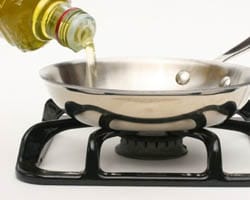
Can you guess what the world’s most-used cooking oil is? You might be thinking soybean oil, or perhaps corn oil, but first place goes to palm oil, accounting for 30 percent of the total production of oils and fats, or 48 million tonnes of oil. Soybean oil comes in second with 23 percent of the market and 37 million tonnes produced.
Palm oil is one of the many questionable ingredients regularly seen on food labels for both natural and conventional foods, but most of us are unsure whether or not it’s safe. Is it an artery-clogger or a healthy fat? The truth is, the jury is still out, but the way the oil is processed gives some insight into its safety.
Palm oil seems to be everywhere: margarine, shortening, baked goods, chocolates, hot beverages, coffee creamers, ice cream, candy, crackers, pastries, cereals, and microwave popcorn. Ninety-three percent of the palm oil produced is used in the commercial food industry. The food industry loves it for two main reasons: it’s cheap and trans fat-free.
One of the least expensive vegetable oils on the market, palm oil’s semi-solid properties makes it a favorite ingredient among food processors. It provides a trans fat-free alternative to partially hydrogenated oils typically used to make pastries, cookies, crackers and other foods requiring long shelf stability and a particular texture.
Its proponents claim that palm fruit oil increases good HDL (cholesterol) promoting cardiovascular health.
Health authorities aren’t convinced, however, that palm oil is a better alternative and question the health claims. Its high saturated fat content, 55 percent, likely contributes to heart disease and isn’t much healthier than trans fat.
With so many mixed messages, it’s no wonder consumers are mystified.
The answer may lie in the type of palm oil used in a product. This is the critical information to look for on a label.
The oil palm tree produces a fleshy fruit from which two oils are extracted: palm oil from the fruit (also called palm fruit oil), and palm kernel oil from the pit. Of the two, palm oil is healthier. It has less saturated fat and provides more antioxidants (in particular, vitamin E, including both tocopherols and tocotrienols).
- Palm fruit oil is made from the flesh of the palm fruit. Naturally semi-solid at room temperature, palm fruit oil does not require hydrogenation and is most often used as a substitute for partially-hydrogenated oils. Red palm oil (unrefined) is healthier than refined (discolored) palm oil and provides more antioxidants including carotenoids (which give it its orangy-red color), coenzyme Q10, squalene, vitamin A and vitamin E. Organic palm fruit oil is available.
- Palm kernel oil: Palm kernel oil is extracted from the seed (or kernel) of the palm fruit. Palm kernel oil is extremely high in saturated fat-about 80 percent-and cannot be obtained organically.
- Fractionated palm oil, the worst kind, is further processed. Fractionated palm oil separates the liquid (palm olein) from the solid portions (palm stearin) of palm oil. The solid fat, palm stearin, contains more saturated fat and fewer antioxidants than palm oil. Manufacturers prefer it for its convenience and its stability. Due to its stability, palm olein is the top choice for frying foods such as instant noodles, French fries, potato crisps, donuts, and fried meats and snacks.
Yet another issue related to the increasing world demand for palm oil is deforestation and destruction of the wildlife of Southeast Asia where the oil is produced. The clearcutting of vast plantations and forests is destroying the habitats of orangutans, tigers, rhinoceroses, and other endangered wildlife. In Malaysia and Indonesia, the world’s top producers of palm oil, several species of animals are already critically endangered.
The demand for palm oil is forecast to double by 2020.




